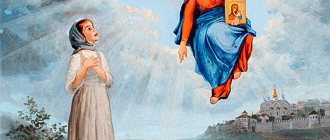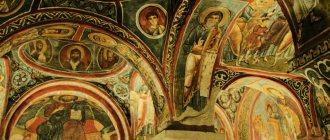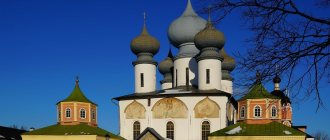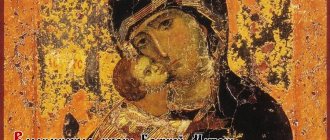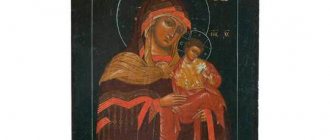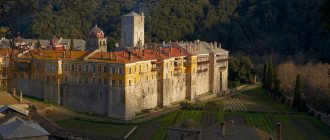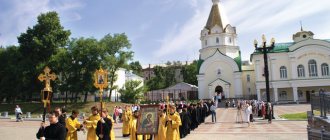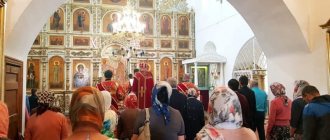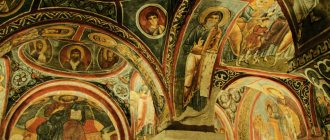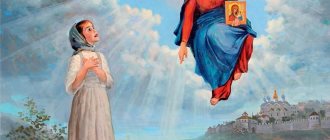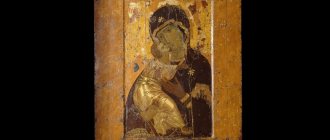In the Christian faith, there are a large number of shrines that are deeply revered by Orthodox Christians in all corners of the globe. There are approximately the same number of shrines in the Catholic faith. But equally sacred for Orthodox and Christians is the image of the Mother of God “Ostrobramskaya”, which has an interesting history of origin and is a single shrine for both Christians and Catholics.
About the author About the book
History of the Ostrobramskaya icon
In the city of Vilnius, in a small chapel today there is this icon. But it has changed its location more than once since the fifteenth century. There is information that the image of the Ostrobramskaya Icon of the Mother of God arrived in the Baltic states in the first half of the fourteenth century.
The image of the Virgin Mary on this icon is incredibly beautiful, and her clothes are a real work of art. You are unlikely to find another similar icon, the design of which uses pearls and precious stones on a par with silver and gold.
Iconography
The image of the Blessed Virgin is painted using tempera (water-based paint) on two thick oak boards, which are covered with a small layer of primer. The holy face belongs to a rare variety, where the Mother of God is depicted without little Christ in her arms. A thorough study and analysis of the execution technique, the composition of the primer and specific paints confirmed that the icon was created by an Italian artist in the middle of the 16th century.
- The figure of the Virgin Mary is covered with a gilded chasuble (applied decoration). Only crossed limbs and a face tilted to the side are open for contemplation.
- At the bottom of the image is a silver crescent, which is considered a votive gift, brought for the sake of healing from terrible illnesses or the fulfillment of various desires.
- On the head of the Mother of God there are two crowns, one of which means reign in heaven, and the second speaks of dominion in Poland. These decorations give off an incredible glow, depicted in the form of bright stars.
The holy image is endowed with restraint, humility and love for its surroundings, despite its grandiose majesty. The iconography here is reminiscent of the variety called “Tenderness,” but surpasses the latter in the pomp of clothing and variety of detail.
Interesting! There is an assumption that the icon of the Ostrobramskaya Mother of God is only a separate part of the picture, which depicts the Archangel Gabriel, who brought Mary the news of the imminent birth of Jesus Christ. The Mother of God bows her head and humbly accepts the news.
However, no evidence was found for this version.
Ostrobramskaya Icon of the Mother of God
Meaning of the icon
The Ostrobramskaya icon of the Mother of God is a majestic image, which, nevertheless, is full of restraint, humility and love. In the icon, the Mother of God is depicted from the waist up, without a baby. Her head is slightly tilted to the side, her eyes are downcast and express humility. The hands are folded crosswise in a prayer gesture. The arrangement is very similar to another image of the Virgin Mary “Tenderness”, only here there is a large number of other details and the pomp of clothing, which is inherent only in this image.
Work as a courier at Yandex.Eda (up to 3,400 rubles per shift) leave a request →
On the head of the Virgin Mary there is a crown and a halo, from which radiance emanates in the form of stars. The image expresses peace and humility, but at the same time, complete confidence in protection and intercession.
As history says, the icon is a Byzantine work of art, which was brought to Vilnia by one of the ruling lands, after battles and wars in Byzantium. That is why it is also called the Korsun Annunciation Icon. According to the second version, this icon was presented in honor of the baptism of the reigning prince at that moment.
There is also a version that this image is just part of a complete picture, which depicts the Archangel Gabriel , who brought the good news to the Virgin Mary that she would soon give birth to the Son of God. With her head bowed in tenderness and complete submission to the will of God, the Mother of God is depicted at this very moment. Although, to this day, no evidence has been found for this assumption.
Although there is still a dispute between Catholics and Christians about the origin of the icon, they quite peacefully share it between religions. Therefore, all Orthodox Christians who wish can venerate the Holy Image of the Mother of God in the city of Vilnius, shoulder to shoulder along with Catholics.
Versions about the origin of the icon
There are several of them. The most basic one, which has a basis, is the Orthodox point of view on the appearance of the image of the Ostrobramskaya Icon of the Mother of God. The Roman Catholics, who currently own the icon, have others. Versions of the appearance of the icon in Vilna:
- Grand Duke Olgerd (1345–1377) obtained it in a victorious campaign against the Crimean Tatars. Theodore Narbut believes: he brought the icon from Korsun (1363), where many Orthodox Greeks lived. Presented as a gift to his beloved wife Maria. Juliana (the second wife) dedicated the image to the Holy Trinity Church.
- There is also an opinion that the miraculous image was sent by the Greek emperor John Palaiologos when he learned about the prince’s adoption of Christianity.
- According to legend, in 1431 an image of the Mother of God appeared above the gate. The icon miraculously revealed itself, just as the Athos Iveron icon once did.
- There are several versions about authorship. The work is attributed either to an Italian artist or to a Dutch one - Martin de Vosa. Other historians - Polish author Luke. In their opinion, the master depicted Varvara (Barbara) Radziwill, the Queen of Poland (16th century).
Note: The temple to which the icon was given by Juliania was erected (1347) on the site of the death of three martyrs for the faith: Anthony, John and Eustathius. Before the adoption of Christianity, Olgerd (Algirdas) executed people, not even sparing close people and friends.
However, it is unlikely that it will be possible to solve the mystery of the origin of the icon. Over many centuries, the image has undergone numerous restorations and renovations. It changed several times, becoming richer and more elegant. Almost nothing remains of the original letter.
Now it is impossible to recognize the Face of the prototype. What secrets are hidden under the rich robe and layers of colors. There is no consensus about its appearance in the city of Vilna. The history of the Ostrobramskaya Icon of the Mother of God is interesting, although confusing.
The meaning of the Ostrobramskaya icon among Orthodox Christians
Almost all Orthodox Christians are united in the idea that the icon is only part of the Annunciation image. Therefore, this shrine is deeply revered among those who seek protection and patronage and the disembodied Heavenly powers. Before this image they also pray against sudden death without holy communion, and for preservation from all misfortune and adversity on the path of life. Also, this icon must be prayed to by those who have:
- Melancholy and despondency, as well as constant doubts about the Christian faith;
- Prayers in front of this icon remove curses up to the seventh generation from the entire family. Therefore, this image is considered especially powerful and should be in the home of every Christian;
- Such an icon should be purchased by those who have a turbulent situation at home, constant quarrels and conflicts. After the icon appears in the house, there is an improvement in the general atmosphere, peace and joy of all its inhabitants;
- Those who suffer from mental disorders and depression should also pray before the holy image to grant healing and protection from demonic machinations;
- The Ostrobramskaya icon protects the house from thieves and fire, as well as any other disaster.
Where to hang an icon in the house
Archpriest Sergius Nikolaev, the author of many books and articles on Orthodox topics, writes about it this way:
An icon in a Christian’s home can be located anywhere. If there is a red corner, then the Ostrobramskaya icon can be placed there among other images. You can place it separately. The main thing is to maintain a respectful attitude towards her. An icon is a symbol, a visible image of an invisible Prototype. In places where sewage is collected (bathroom, pantry, etc.) placing icons is not only unreasonable, but also blasphemous. The image must be positioned so that it is clearly visible, so that it is convenient to pray in front of it. The icon serves for concentration and prayerful composure.
Each person determines the number of icons independently. Everything needs moderation. You should not completely decorate your home with images; this is not a guarantee of spiritual benefit. One or several icons for each room is enough. Those icons that for some reason did not find a place should not be put away in a distant drawer.
It is better to give them to someone who needs it.
One should not attribute magical properties to an icon, much less assume that its help depends on where it hangs. This view is deeply erroneous and has pagan underpinnings. For example, the Ostrobramskaya icon is traditionally located above the gates of Vilnius. By analogy, you can hang it above the front door. But this is not an absolute condition, but only one of the options. The main thing is fervent prayer with faith.
For many centuries, the bright face of the Mother of God has been looking out from the holy icons. Like a Meek and Loving Mother, She listens to the prayers of Her children. It lifts you above the vanity of the world, pacifies passions, heals illnesses, and encourages prayer and piety.
Miracles performed through the prayers of believers in front of the Ostrobramskaya icon
Become a courier of the Yandex.Food service right now (up to 3,400 rubles per shift) leave a request →
A large number of miracles have been recorded from different parts of the world, through the prayers of Christians before this holy image. Through the prayers of his mother, who fervently cried out to the Mother of God, her son began to speak, and the retardation in the development of the speech apparatus completely disappeared. The second mother, inspired by example, also prayed earnestly in front of the image for her terminally ill child.
And a miracle happened: the baby was incredibly healed from a serious illness - leukemia . There have also been cases where missing or kidnapped children returned home safe and sound through the prayers of their parents in front of the Ostrobramskaya icon. Therefore, the Mother of God, as a caring mother of the entire Christian race, helps everyone who turns to Her with fiery prayer and deep faith.
Miracles accomplished
Numerous gifts confirm that the prayer has been answered. The crescent moon is also gratitude for some great help received by the Polish Christian. In Kyiv there is a list from the Ostrobramskaya shrine. According to people's reviews:
- The mute child spoke immediately after the family prayed in front of the icon.
- The parents found and returned home their daughter, who had gone to China. And it's free.
- The couple were able to get pregnant after 10 childless years.
- Healing a 4-year-old boy from leukemia.
Many people purchase the Ostrobramsky icon for home prayer. They believe that thanks to the Most Pure Virgin, peace and prosperity are maintained in the house, and children become more respectful to their parents. The Mother of God helps with mental disorders, depressed mood, and family troubles.
How and where it is necessary to place the “Icon of the Mother of God”
In order to protect your home from everything bad, this icon must be placed directly above the front door of the house or apartment. The icon should look into the house, and not vice versa. Before placing it in its place, it is necessary to read the prayer of the Mother of God and only after that, place the image in the prepared place.
According to many Christians, after such an icon appears in the house, some friends and acquaintances may visit you less often. And over time, they will completely forget the way to you. This means that Our Lady took these people away from your home because they could pose a threat to you or your loved ones. In general, this fact is quite interesting, and many note its reliability and amazingness.
Miracle performed by the Holy Image
- Cure from infertility . For 10 years, Vitaly and Elena could not become happy parents. Elena's husband, having learned that a temple was being built in honor of the Mother of God, took an active part in the construction work, and they became one of the first who were able to pray to the divine face in the new temple. After this, Elena was able to get pregnant and soon gave birth to a beautiful girl.
- Return of abducted children . There have been recorded cases of abducted and missing children being returned to their parents, in some cases without any conditions.
- Search for missing people . The Saint also helps in finding missing relatives. For more than a year, Galina’s daughter did not contact her mother. She went to work in Japan and disappeared there. Galina began to pray to the image every day for help, and very soon people were found who helped her daughter return home in a short time.
And these are not all the miracles that the divine face has done for people sincerely asking for help.
Collection of answers to your questions
It is difficult to meet an Orthodox person who does not know what the Ostrobramskaya Icon of the Mother of God looks like, what it protects from and how to handle it correctly. It is one of the most famous shrines in the Catholic world. To this day, there are several versions of its origin.
A few historical facts
In accordance with the translation from Latin, the Ostrobramskaya icon takes on the meaning of an entrance gate. That is why for the first time its location was a fortress fence in the city of Vilna. One source indicates that the date of its foundation is considered to be April 27, 1431
. Orthodox people characterize her with the best adjectives: luxurious, beautiful and radiant. It was brought from a Crimean city. The second wife of Prince Olgerd gave the shrine to the church.
In 1671 it was moved to a wooden chapel built near the gate. During the war years it was guarded by several Swedish soldiers. There are several legends about the shrine.
- In 1702, the icon saved the life of a small child;
- Once during all this time she fell and caused serious harm to the soldiers;
- In 1706 and 1714 the chapel burned, the icon itself found in it was completely undamaged by the fire;
- In 1795, every person of military rank had to pass under this icon;
- For several centuries in a row, Orthodox people have been approaching this icon to confess.
In 1830, a new chapel was built for the shrine. The icon also underwent reconstruction, which was carried out by the painter K. Rusetsky. the coronation of the Virgin Mary took place in 1927
.
The meaning of the Ostrobramskaya Icon of the Mother of God
Orthodox people claim that the Ostrobramskaya icon is of great importance in the Christian world.
- Its main purpose is protection from dark forces
. During wars and battles, crowds of people approached her to ask for peace; - There is a rumor that it can protect against the evil eye, gossip and envy; it is not surprising that it is often placed in the workplace
; - It can also help a person get rid of an existing curse or reduce its effect;
- People in relationships also strive to approach this icon so that harmony appears in their relationships;
- They place it in houses so that they have a calm atmosphere;
- In some health centers you can see this shrine. The main purpose of her presence is to get rid of depression
, restore the body and psychological calm; - It is also given to spouses as a symbol of fidelity;
- An icon can also bring good luck in many endeavors.
Based on the fact that it is of great importance in the Orthodox world, it is not difficult to guess that the image of the shrine is found almost everywhere: in churches, at work, at home, in a hospital, in a kindergarten, in educational institutions and even in enterprises.
What does the icon look like?
To this day, the shrine is located above the Ostrobramsky Gate of the city of Vilnos. For Lithuanian believers it is of great importance. You can notice that thousands of people approach her every day to pray for help for themselves and their loved ones. People come from all over the world for only one purpose - to bow before her.
Especially many believers can be seen at the Ostrobramsky Gate on Orthodox holidays. The Feast of Respect for Catholics is celebrated on April 27, and December 26 is considered the day of the Ostrobramsky Icon.
How to pray correctly?
It is best to pray in the chapel itself
. If this is not possible, then you can do it at home. It is not recommended to eat for several hours before prayer, lie or sin. All thoughts must be pure; you must approach the icon sincerely. Women are advised to cover their heads with a light material similar to a silk scarf. It is also not recommended to wear revealing clothing.
Of course, when praying at home, you don’t have to change your clothes.
. It is advisable to wash your face with holy water first. In front of the icon you need to light a candle lamp. There should be complete silence in the room. During prayer, it is recommended to free your head from bad intentions. The prayer itself is a sincere request for help. After it, you must definitely say “Amen”, cross yourself and bow.
Where is the best place to put an icon at home?
Every home should have the Ostrobramskaya Icon of the Mother of God. What does it protect against? First of all, from enemies. Therefore, it is recommended that it occupy a position in the right corner opposite to the entrance door. There should be no other objects near it. It should be ensured that the shrine is always kept clean
Pay more attention to its appearance, wipe the dust off it more often
A Brief History of Three Martyrs
Olgerd allowed Christianity to be practiced in his domains while his wife was alive. As soon as Mary died, the prince unexpectedly began to support the fire-worshipping priests, and therefore the prince subjected those who spoke about God to cruel punishment. One of these were Anthony and John. But despite the fact that half their lives were spent in prison, they continued to preach the name of the Lord, for which both were hanged on an oak tree, which later became a truly sacred place for Christians.
Another man devoted to God, as legend says, Eustathius was the favorite warrior of Olgred himself. But despite what privileges awaited him in the future, if he gave all his devotion and love to the prince, Eustathius completely and completely devoted his soul to God. According to legend, this truly holy man was brutally tortured before his death, forced to drink ice water in the cold, completely naked. Despite all this horror, he remained indifferent to everything that was happening, charging with his faith and divine energy. Later, by order of the Lithuanian prince, the “divine warrior” was hanged on the same sacred oak tree.
After the Union of Brest, at the end of the 16th century, the Trinity Church was transferred to the Uniates, so the Ostrobramskaya icon was placed in one of the parish Orthodox churches. And in 1906, the image was captured by the Uniates and installed in the chapel above the Sharp Gate.
In 1625, the image began to belong to the Latin Carmelite monks, who placed the shrine in the church built in honor of St. Teresa.
At the beginning of the 19th century, the Ostrobramskaya icon came into the possession of the Roman Catholic clergy. And in 1927, on July 2, a solemn coronation took place (under the leadership of Pope Pius XI) in the presence of the entire Polish episcopate.
